Longnose Skate
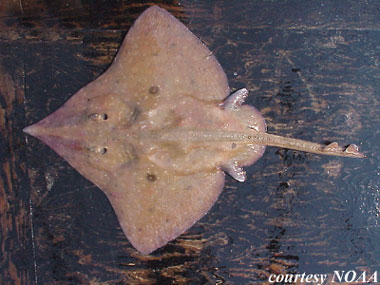
Raja rhina
This angular skate has a very pointed snout and triangle pectorals fins, with lobed pelvic fins alongside a stout tail. It is a dark brown, deal for living on a sandy bottom partially submerged in sand, and there are two small dark eye spots on its fins, each with a light center and light ring. There are denticle thorns near its eyes and down along its tail, but it is shy and not considered a danger to humans.
It lives in the northeastern Pacific region on coastal shelves where it feeds on small fishes and invertebrates.
Order: Rajiformes
Family: Rajidae
Genus: Raja
Species: rhina
Common Names
Common names include longnose skate (English), gandah (Tsimshian), f’ak’ew’ (Salish), langsnuitrog (Dutch), raja dlugonosa (Polish), and raya narigona (Spanish).
Importance to Humans
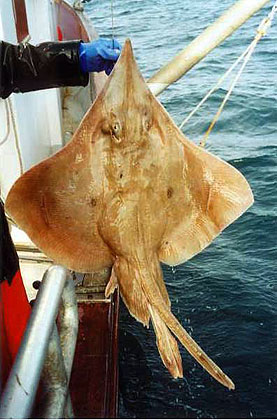
The longnose skate is of only minor commercial fisheries importance. However, it is taken incidentally as bycatch primarily by bottom trawlers in the waters off northern and central California. The pectoral fins are sometimes marketed as “skate wings” and presumably as scallops (punched from the pectoral fins) although the flesh of skates is not highly regarded for human consumption.
Historically, the skate fishery has been of only minor economic importance compared to other commercial fisheries. However, the market price of skate wings increased from $.01-$.02 per pound prior to 1970 to $.25 per pound in 1991. In the late 1990s, the price ranged from $.40 to $1 per pound, making the skate a more attractive catch.
During the 1990s, the skate catch off the coast of California increased nearly ten-fold. This is in part due to the increased take by the trawl fishery which supplements its income by marketing skates and rays taken as bycatch. The impact on the populations of skates and rays due to the increased fishing pressure is uncertain at this time.
Danger to Humans
Although regarded as harmless to humans, the longnose skate must be carefully handled due to the thorns on its body and tail. Divers are often able to approach longnose skates, however if closely approached or harassed, skates will swim away.
Conservation Status
The longnose skate is not listed as endangered or vulnerable with the World Conservation Union (IUCN). The IUCN is a global union of states, governmental agencies, and non-governmental organizations in a partnership that assesses the conservation status of species.
> Check the status of the longnose skate at the IUCN website.
Although landings of the longnose skate are increasing in waters off the coast of California, it is difficult to assess how this impacts the current population level. Skates mature at a late age, have slow growth rates, and low reproductive rates. All these factors make skates potentially vulnerable to overfishing and as such, warrant close monitoring of populations. In regions other than California, due to a reduction in landings, it appears that skates have been overfished and are suffering reduced population levels
Geographical Distribution
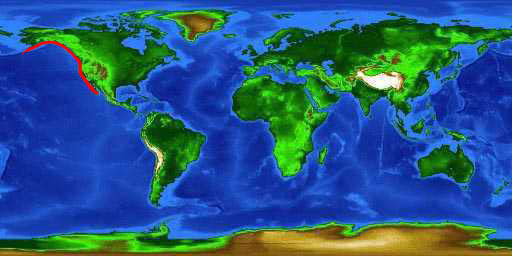
The distribution range of the longnose skate is limited to the eastern Pacific Ocean within 61°N – 28°N. This range includes Navarin Canyon in the Bering Sea and Unalaska Island, Alaska south to Cedros Island, Baja California, Mexico.
Habitat
The longnose skate is commonly found on the floor of the sea, occurring at depths ranging from 82-2,215 feet (25-675 m). As a bottom dweller, it is often observed partially or entirely buried in sand and silt bottoms with its eyes protruding above the surface. The coloration of this skate is used to camouflage it with the bottom substrate. To move, the longnose skate undulates the pectoral fins in a graceful sweeping motion, appearing to fly rather than swim through the water.
Biology
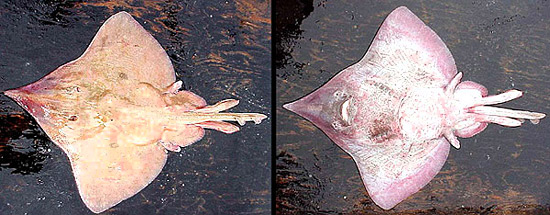
Distinctive Features
The body of the longnose skate is flattened and not clearly defined from the pectoral fins or head. The anterior margin of the disk (body) is strongly concave. The pectoral fins are broad. The snout is stiff, long, and acutely pointed and the mouth is directed downward. The five gill slits are located ventrally and spiracles are large and behind the eyes on the dorsal surface. The small dorsal fins are closely spaced and located on the tail. The pelvic fins are deeply notched into two lobes. The caudal fin is reduced to a low ridge on the tail and the anal fin is absent.
The longnose skate is similar in appearance to the California skate (R. inornata). However, the California skate can be distinguished by rounded pectoral fin tips and it is a shallow water species, only very rarely occurring in water deeper than 40 feet (12.2 m).
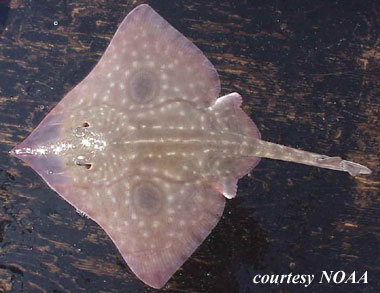
The deepsea skate (Bathyraja abyssicola) is also sometimes confused with the longnose skate. While the deepsea skate also has a long snout, its snout is thicker than the longnose skate’s snout. The deepsea skate also lacks orbital thorns.
Another skate similar in appearance to the longnose skate is the big skate (Raja binoculata). The snout of the big skate is less pronounced and the anterior margins of the pectoral fins are less concave than the longnose skate. Coloration patterns also differ with the big skate having large dark spots on the pectoral fins that lack pale centers in contrast to the longnose skate that has spots with pale centers and borders.
Coloration
The dorsal surface of the longnose skate is dark brown with a dark eyespot on the base of each pectoral fin. Each eyespot has a pale center and border. There may also be a light spot located just behind the eyespot. The ventral surface is bluish, gray-black or light brown in color.
Dentition
Dentition of the longnose skate consists of small teeth arranged in diagonal rows. Each tooth is plate-like with a very small cusp.
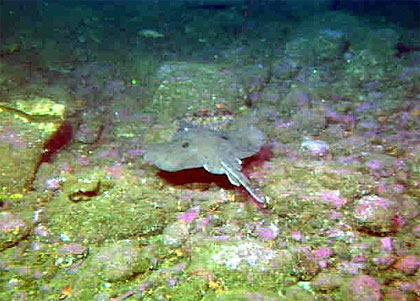
Denticles
There are approximately 20 sharp mid-dorsal thorns running along the tail. One to two dorsal mid-dorsal thorns are located just posterior to the eyes and there is a discontinuous row of thorns around the inner edge of the orbit.
Scales on the longnose skate are placoid in shape and very small. There are a few scales located on the snout and on the ventral surface of the anterior edge of the pectoral fins.
Size, Age, and Growth
The maximum reported size of the longnose skate is 4.6 feet (140 cm) total length with individuals averaging 2-3 feet (.6-.9 m) total length. Males are generally much smaller than females. Males mature at 2-2.4 feet (61-74 cm) and females at 2.3-3.3 feet (70-100 cm) total length, correlating to 6-9 years of age. The life span of this species is currently unknown, although individuals up to 13 years of age have been reported.
Food Habits
The longnose skate feeds on small fishes and invertebrates including crustaceans, worms and mollusks. Skates feed by pouncing on top of its prey, trapping it against the sea floor.
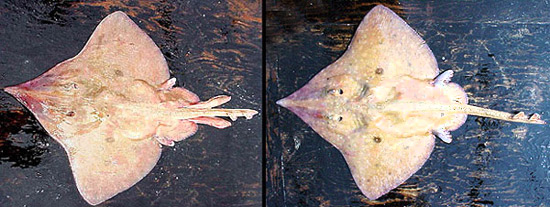
Reproduction
Skates are oviparous, or egg laying, animals. Elasmobranchs have internal fertilization with the male inserting one clasper into the female cloaca to deliver the sperm. After fertilization, the female forms a tough, permeable egg case that surrounds the egg.
After a period of several months, the female deposits the egg on the sea floor. The egg case is oblong with hook-like horns on each corner and measures about 3.9 inches (10 cm) long and 2.4 inches (6 cm) wide.
The embryo continues to develop with nourishment provided by a yolk. When the yolk is depleted a few months later, the embryo exits the egg case. Upon hatching, the young skate is similar in appearance (other than size) to an adult longnose skate.
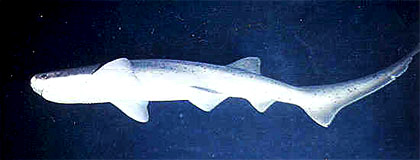
Predators
The longnose skate falls prey to large bony fish and sharks. Adaptations for predator avoidance includes camouflage coloration as well as the ability to bury themselves in sandy or silty bottoms. Thorns on the tail and near the eyes also deter predators from making the longnose skate a potential victim.
Snails and marine mammals often consume the egg cases of the longnose skate.
Parasites
Many fishes have Myxosporean (class Myxozoa) parasites in their tissues with the longnose skate being no exception. Sphaerospora araii n.sp. has been documented from the kidney of a longnose skate captured in the eastern Pacific Ocean in waters off Canada.
The nematode Capillaria freemani sp. nov. is also a parasite reported from the longnose skate.
Taxonomy
In 1880, Jordan & Gilbert originally described the longnose skate as Raia rhina which was later changed to the currently valid name Raja rhina. The genus name Raja is derived from the Latin “raja” meaning skate and the species name rhina is derived from the Greek “rhinos” meaning nose. There are no known synonyms used to refer to this species in past scientific literature.
Prepared by: Cathleen Bester